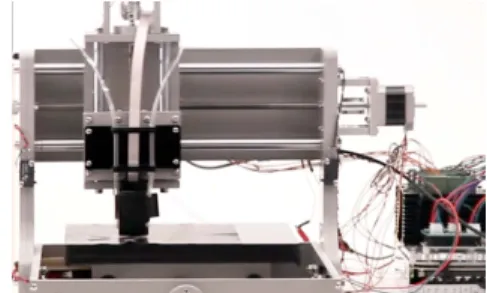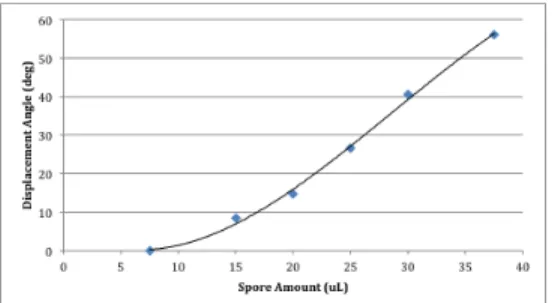bioPrint: an automatic deposition
system for bacteria spore actuators
The MIT Faculty has made this article openly available.
Please share
how this access benefits you. Your story matters.
Citation
Ou, Jifei, Lining Yao, Clark Della Silva, Wen Wang, and Hiroshi
Ishii. “bioPrint: an automatic deposition system for bacteria spore
actuators.” Proceedings of the Adjunct Publication of the 27th
Annual ACM Symposium on User Interface Software and Technology
- UIST’14 Adjunct (Poster) (2014), October 05-08 2014, Honolulu, HI,
USA.
As Published
http://dx.doi.org/10.1145/2658779.2658806
Publisher
Association for Computing Machinery (ACM)
Version
Author's final manuscript
Citable link
http://hdl.handle.net/1721.1/103762
Terms of Use
Creative Commons Attribution-Noncommercial-Share Alike
bioPrint: An automatic deposition system for Bacteria
Spore Actuators
Jifei Ou
1Lining Yao
1Clark Della Silva
1Wen Wang
2Hiroshi Ishii
11 MIT Media Lab
{jifei, liningy, clarkds, ishii}@media.mit.edu
2 MIT Chemical Engineering
wen.eve.wang@gmail.com
ABSTRACT
We propose an automatic deposition method of bacteria spores, which deform thin soft materials under environmental humidity change. We describe the process of two-dimensional printing the spore solution as well as a design application. This research intends to contribute to the understanding of the control and pre-programming the transformation of future interfaces.
INTRODUCTION
It has been shown in earlier work that the Bacillus Subtilis spore can be used to bend and release a thin sheet substrate, due to this spore’s hygroscopic behavior. The resulting mechanism has a high energy density (10.6 MJ/m³) and is easy to assemble. Inspired by these results, we introduce a computer controllable system to deposit structures of spore solutions onto substrate geometries to achieve a wide variety of shape transformations. While most prior work focuses on programming the biological materials at nano and micro scales, we believe that this approach can also add to the programmability at the macro (human) scale, so that such materials can be used in the field of Human-Computer Interaction and Design.
Figure 1: (a) SEM scanning of bacillus subtilis spores applied on a latex substrate (b) Bending of latex substrate material with spores as surface attachment.
RELATED WORK
Developing stimuli-responsive and “smart” materials, especially polymers [3], is a growing field in chemistry. A paper published by Nature Nanotechnology introduced Bacillus spores (originated from Bacillus bacteria) as a potential building block for humidity responsive materials [1]. The magic of actuation lies in the cortex of the
Bacillus spore [2]. It absorbs water and swells when relative humidity (RH) increases and releases water, returning to its original size when RH decreases.
BIO-PRINTER
In order to achieve a higher accuracy of shape-change driven by the spores, we built an automatic depositing system that can apply the spore on the substrate material.
Hardware Setup
The system consists of two parts: a printhead that can spray tiny droplets of spore solution and a desktop CNC milling machine that can move the printhead in three-axis (Figure 2).
Figure 2: Setup of bacteria spores printer.
Printing is accomplished using a small CNC router (available from zentoolworks.com) modified to accept the print head. We designed a customized printhead to hold the inkjet cartridge carrier in place, and stabilize two pneumatic tubing, which accelerates the drying process of the spore solution by constantly blowing gentle air onto the substrate while printing.
We used an Arduino InkShield (available from http://nicholasclewis.com) to control the deposition of the spore actuators. The InkShield uses HP C6602A cartridge, which has 12 nozzles that can be individually controlled. This attribute gives us the space to easily vary the density and the resolution of the spores for each print. Customized Printing Path and G-code
For converting the printing pattern to machine toolpath, we used a free web-based software Makercam. The software converts an SVG file to G-code file for the milling machine to read. Since the generated CNC G-code contains spindle and Z-axis control, yet lacks of inkShield control, we have to customize the motor control board and the G-code to fit our system. The InkShield is controlled using the spindle head enable output of the motor control board. This output is connected to the arduino controlling the print head, and the print head is enabled when the spindle enable line goes high. The G-code is then modified to bring the spindle enable line high after the
Permission to make digital or hard copies of part or all of this work for personal or classroom use is granted without fee provided that copies are not made or distributed for profit or commercial advantage and that copies bear this notice and the full citation on the first page. Copyrights for third-party components of this work must be honored. For all other uses, contact the Owner/Author.
Copyright is held by the owner/author(s). UIST '14, Oct 05-08 2014, Honolulu, HI, USA ACM 978-1-4503-3068-8/14/10.
print head has moved to the correct height. In contrary, for a normal CNC router, the spindle enable is brought high and then the head is moved down to start cutting. By starting to print after the head is moved down, excess spray of the ink is prevented.
Printing Process
To replace the ink in the original cartridge with spore solution, we carefully cut out the top cap of the cartridge and rinsed both the cartridge and the sponge inside. After they completely dried, we pour 5 mL spore solution in the cartridge and soak the sponge in. The top cap needs to be taped back on the cartridge body so that the cartridge can be snapped into the carrier. An ultrasonic cleaner is also necessary as the nozzles of cartridge can be blocked by the impurities. Figure 3 shows the whole printing process.
Figure 3: Printing Process
Flow Rate of Spore Deposition
We can calculate the speed of spore deposition from the equation:
S = Sn × D, (1)
where Sn is the speed of nozzle jetting and D is the density
of spore solution. The density of spore solution we use is 5.25×109 per milliliter. The speed of a single nozzle
jetting is 0.24uL per second. Therefore in our test the actual speed of spore deposition is 1.26×106 per second. Machine Feed Rate and Material Bending Angle Based on our test experience, the optimum parameters to cover the surface nicely are with print head diameter (liquid drop) D as 0.5mm and step over p as 20%. Once these two parameters are set, feed rate v is directly related to the bending performance of the final sample.
Table 1: Change of displacement angle with spore amount with a sample size of 5mm * 20mm
Table 1 shows that the displacement angle of a 5mm by 20mm material sample is directly related to the spore amount. The table holds true as long as the sample width to height ratio is 1:4. Based on table 1, a desired angle α corresponding to a spore volume V. The amount of spore we need for every square millimeter sample (ρ) can be calculated as
ρ = V / 20 × 5 = 0.01V, (2)
For the feed rate v, since inkjet volume at certain amount of time t should equal to the desired volume of spore at the size covered by the same printing time:
S×t = v × D × p × t × ρ, (3)
Machine feed rate v can be calculated based on (2) and (3):
v = S / (D × p × ρ) = 1.26 × 109 / V. (4)
APPLICATION
We are inspired by the natural anisotropic structure of material composites, whose shape can be programmed into the materials’ micro or larger structures, we print leaves with different shapes. Spore actuators follow the vein structure of certain leaves, which creates biomimetic transformation of the leaves that resemble the real natural organisms (Figure 4). Considering lots of natural leaves transform due to the gain and loss of water inside the veins, here spore actuators swell and shrink to create the similar effect.
Figure 4: Spore actuators follows the vein structures of leaves to create biomimetic transformation.
We then apply the transformable leaves to the design of living tea bags. The leave on top of the tea bag curls up at the beginning. After pouring hot waters into the teacup, the curled leaves will slowly unwrap, to indicate the tea bag is fully soaked in the water. Once the tea is ready and the tea bag is pulled out of the cup, the leave will curl up again to hint the end of its life. (Figure 5)
Figure 5: Tealeaf unwraps to indicate the tea is ready, and curls up again after use.
REFERENCE
1. Chen, X., Mahadevan, L. Driks, A and Sahin O. Bacillus spores as building blocks for stimuli-responsive materials and nanogenerators. Nature Nanotechnology 2014, 9, 137–141.
2. McKenney, P.T., Driks, A., Eichenberger, P. The Bacillus subtilis endospore: assembly and functions of the multilayered coat, Nature Reviews Microbiology 2013, 11, 33-44 Meng, H., Li, G. Reversible switching transitions of stimuli-responsive shape changing polymers, J. Mater. Chem. A, 2013,1, 7838-7865. 3. Meng, H., Li, G. Reversible switching transitions of
stimuli-responsive shape changing polymers, J. Mater. Chem. A, 2013,1, 7838-7865.

